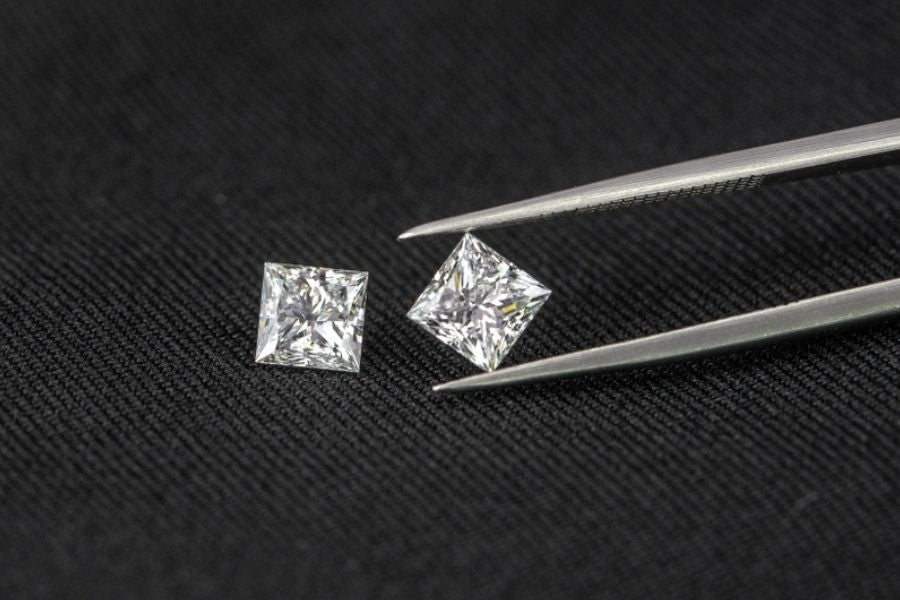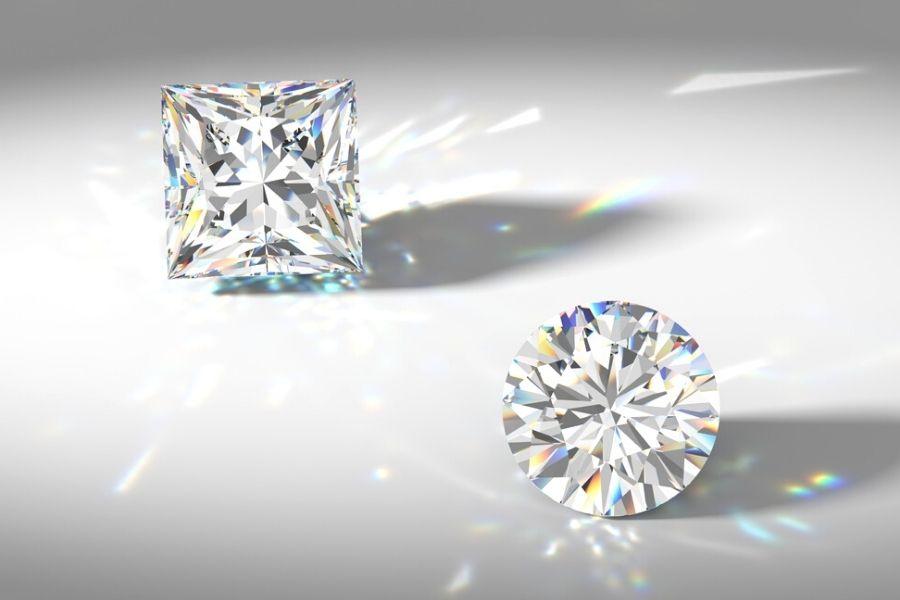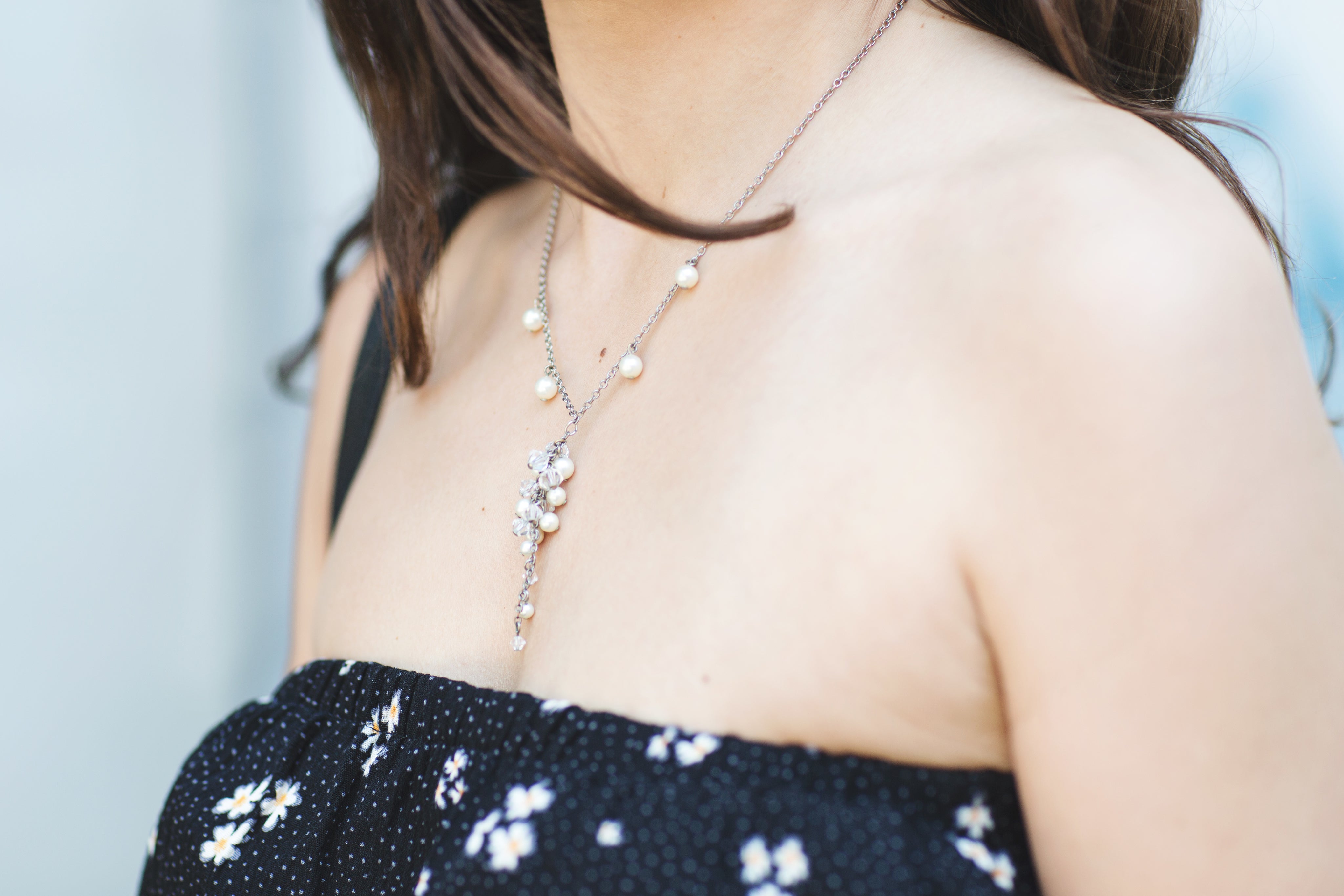
Now that you’ve found the perfect partner to spend the rest of your life with, it’s time to choose the perfect engagement ring. But with so many styles to choose from, how can you decide which one is best?
This guide will break down the pros and cons of the two most popular diamond shapes: princess cut vs. round cut diamonds.
Let’s get started with the princess cut.
The Princess Cut Diamond
The princess cut diamond is second in popularity only to the round cut diamond. This modern style looks like an inverted pyramid with a square or rectangular base and beveled edges.
This cut is one of the newer diamond shapes and was created in 1961 by a London diamond cutter named Arpad Nagy. He originally called it the “profile cut,” and it’s gone through a few changes since then, arriving at its current shape in about 1980.

The current iteration of the princess cut diamond boasts 58 facets, allowing it to sparkle more than most other cuts. However, only 20% of the rough diamond goes to waste when cutting princess diamonds, so they’re more economical than other shapes.
You’ll sometimes hear princess cuts called a “square modified brilliant” because it combines a square shape with the brilliance of a round cut.
The Round Brilliant Cut Diamond
The round brilliant cut diamond is by far the most popular diamond shape for diamond engagement rings.
This classic shape has been around since the 17th century, although advances in technology over the centuries have ushered in round brilliant cuts with more precision and symmetry than in the past.
Like the princess cut diamond, round brilliant cut diamonds have 58 facets, 33 of which are on the crown and 25 of which are on the pavilion. These facets allow light to enter and refract from all angles, giving it outstanding brilliance and sparkle.
Brilliant cut diamonds offer even more sparkle than princess cuts, but their beauty comes at a price. A whopping 60% of the rough diamond is wasted when cutting round brilliant diamonds. This makes them the most expensive diamond cut.

Princess Cut vs. Round Cut: Color
When you hear people talking about a diamond’s color, what they’re actually talking about is its lack of color. That’s because the higher in quality a diamond is, the more clear it is.
The clearer a diamond is, the more easily it can reflect color, adding to its brilliance and shine. Whenever you can, go for the clearest diamond you can afford.
It’s worth noting, though, that clear diamonds are hard to come by, which you’ll see reflected in a higher price tag.
Lower quality diamonds have hints of yellow or brown - the more hints of color they have, the less light they reflect, and the lower the quality. The exception to this, of course, is when you’re purchasing colored diamonds on purpose. In this case, colored diamonds, especially red and blue, can be far more expensive than even the most flawless colorless diamond.
Because round cut stones reflect more light than princess cut diamonds do, they’re better at hiding color. This makes them a better choice if you’re not able to find a diamond that’s as clear as you’d like.
Princess Cut vs. Round Cut: Brilliance and Sparkle
Princess and round cut diamonds are incredibly brilliant, reflecting more light than other cuts.
Both of these cuts feature 58 facets. Facets are the term for the number of surfaces a diamond has, which allow it to receive, refract, and reflect light. The more facets a diamond has, the more brilliance and sparkle it will emit.
Although they’re quite similar, the slight differences in round and princess cuts do make a difference. Brilliant round cut diamonds reflect over 90% of the light that passes through them, whereas princess cut diamonds reflect only 70%.
Princess cut diamonds perform brilliantly, but round cut stones take the prize in this comparison.
Princess Cut vs. Round Cut: Price and Value
You probably won’t be surprised to learn that the most popular diamond cut, the round cut, is also the most expensive. There are a couple of reasons for this.
Round Cut Diamonds Require More Raw Material

As we mentioned earlier, over half of a rough diamond goes to waste during the process of cutting a brilliant round cut diamond. This drives the price up because it takes more raw material to make an average-sized stone, and that gets factored into its overall value.
Round Cut Diamonds Are in Higher Demand
Because round cut diamonds are by far the most popular for engagement rings and other jewelry, they’re in high demand. As you probably already know, high demand is always reflected by higher market value, and therefore, higher prices.
The stunning brilliance of round cut diamonds makes them worth the extra investment in many people’s minds.
What About Princess Cut Diamond Prices?
Princess cut diamonds are always less expensive than an equivalent round cut diamond, so they’re a better option for those on a budget.
If you’re looking for an even more affordable option, choose rectangular or irregular shapes since they cost less than square shapes. This is due to the same reason as round cut diamonds - reshaping a diamond into a perfect square wastes more material than leaving it in an irregular shape.
Princess Cut vs. Round Cut: Clarity
Where a diamond’s color refers to whether it’s clear or tinted, the term “clarity” refers to whether or not a diamond contains imperfections.
- Inclusions: internal imperfections
- Blemishes: external imperfections
As with color, brilliant round cut diamonds are better at hiding or camouflaging inclusions and blemishes due to light reflections and refractions. That said, princess cut diamonds do an excellent job of it.
Naturally, flawless diamonds cost significantly more than flawed diamonds. A diamond’s clarity is rated using the GIA Clarity Grading Scale, which has eleven grades. Note that the classifications are given when a skilled grader is using 10x magnification.
- Flawless (FL) - No visible inclusions or blemishes
- Internally Flawless (IF) - No inclusions. Visible blemishes
- Very, Very Slightly Included (VVS1 and VVS2) - Barely visible inclusions
- Very Slightly Included (VS1 and VS2) - Minor inclusions that are difficult to somewhat easy to see
- Slightly Included (SI1 and SI2) - Noticeable inclusions
- Included (I1, I2, and I3) - Obvious inclusions that that might affect transparency and brilliance
When comparing for clarity, a general rule of thumb is the smaller the stone, the more obvious imperfections will be. Therefore, it’s a good idea to spring for a flawless or nearly flawless stone if yours is one-carat weight or less.
Princess Cut vs. Round Cut: Which Looks Bigger and Better?

Mathematically speaking, if you were to measure a round cut diamond’s surface, it would be larger than a princess cut one. However, optical illusions are a tricky thing, and our eyes often deceive us.
Princess cut diamonds have larger tables (the diamond top) than round cut ones do, so they look larger to the naked eye.
Another thing worth keeping in mind is that since princess cut diamonds are less expensive, you can buy a larger princess cut stone due to the price difference. That makes them the clear winner if you’re looking to impress people with size.
Princess Cut vs. Round Cut: Durability and Your Lifestyle
It’s normal to worry about things like style and cost when selecting a diamond engagement ring, but another important factor to take into consideration is the wearer’s lifestyle.
Because they have corners, princess cut diamonds are more prone to catching and snagging on things, making them uncomfortable for active people who do a lot with their hands. For this reason, you might consider a round cut diamond if the person has an active career or lifestyle.
At the very least, consider setting the diamond in a protective bezel setting that surrounds the stone rather than a prong setting.
Princess Cut vs. Round Cut: Most Popular Settings
You’re probably starting to get a pretty clear picture of whether a round or princess cut is the right one for you. Once you have the stone squared away, it’s time to think about the setting.
There are an endless variety of settings to choose from, and you can even have one custom-made if you choose. But for now, we’ll focus on the most popular diamond engagement ring settings for princess and round cut diamonds.
Prong
The most popular setting for both round and princess cut diamonds is the prong setting, in which the diamond is suspended using four or six prongs.

This setting makes the most of a diamond’s brilliance since it holds it up for light to shine through virtually unobstructed. However, the prongs are prone to catching on hair and clothing, so they’re not ideal for active lifestyles.
Bezel
Bezel settings, which protect the diamond all the way around, are the second most common type for engagement rings. This setting style offers the most protection and eliminates snagging, but it also drastically reduces the amount of light that can pass through your diamond.

Princess Cut vs. Round Cut: Which is Better?
Only you can decide which ring is the right one. While there are plenty of standards and grading scales set in place to determine quality, a diamond ring has to reflect its owner’s taste and lifestyle in order to be truly valuable.
It’s important to consider the cut of a diamond when shopping, but other factors, like size, clarity, and color also come into play.
Whether you opt for a traditional round cut diamond for that classic look or a modern princess cut for a more contemporary style, choose an elegant engagement ring, and it will never go out of style.
Summary & How To Choose The Right One
There aren’t many choices in the world more personal than choosing the right diamond engagement ring.
If brilliance and sparkle are important to you or you want an evergreen ring that will stand the test of time, go for a brilliant round cut diamond.
If, on the other hand, you prefer size over brilliance or want a larger stone for the same price, a princess cut is just what you’re looking for.






Leave a comment